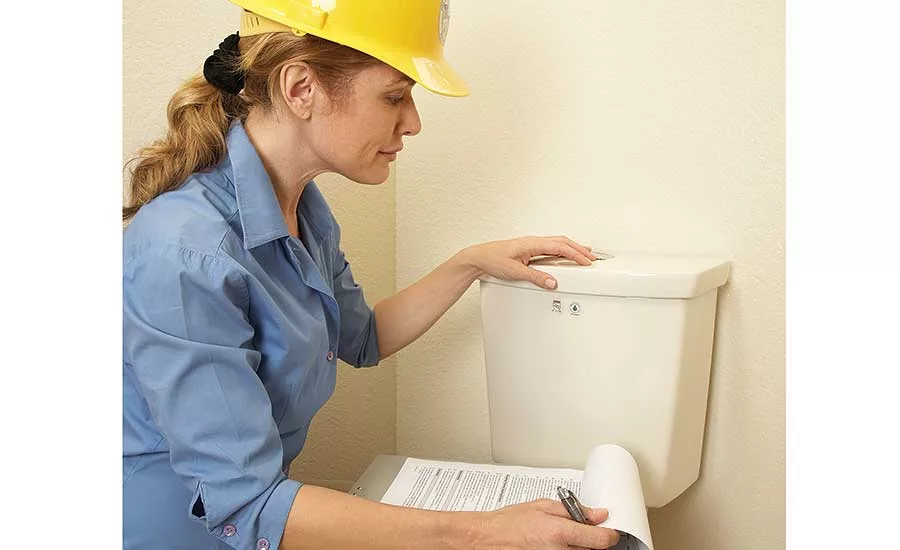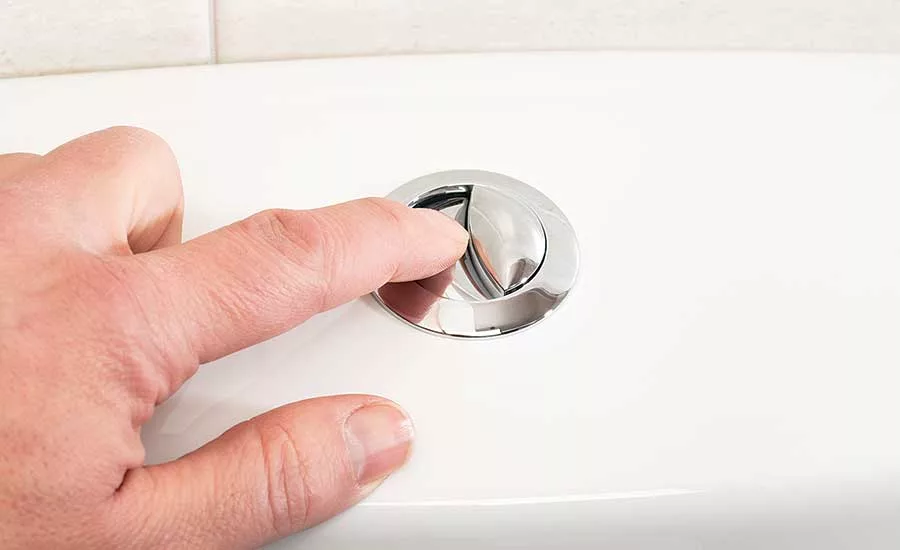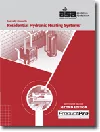WaterSense looks to cut residential water use by 20%
A home with a higher IQ.

Roughly 17 to 20% of residential water use can be attributed to the shower, accounting for 1.3 trillion gallons of water in the U.S. every year, per the EPA. Photo credit: IAPMO

The first product to receive the WaterSense label was the high-efficient toilet (HET). HETs are old news by now, but they reduce the standard 1.6 gallons per flush to 1.28 gpf. There are more than 160 models offered by various manufacturers. Photo credit: IAPMO

Many cities are following the lead of California, which passed a law mandating that all new homes constructed in 2014 install toilets with 1.28 gpf or less.

Tim den Hartog
How much water does a home use on a daily basis? Five or more minutes in the shower, a couple minutes brushing your teeth, flushing the toilet numerous times throughout the day, running the dishwasher or doing a load of laundry?
Add that all up and you may be amazed at the total amount. Most studies put the number between 80 to 100 gallons of water per person per day. Overall, residential water use accounts for 47% of all water supplied to communites, according to the U.S. Environmental Protection Agency (EPA). The EPA’s WaterSense program has been working to reduce that number by promoting water-efficient products and services through its WaterSense label.
Since its launch in 2006, the WaterSense label has become as prevalent as the EPA’s blue Energy Star logo. In a nutshell, the WaterSense label makes it easy for consumers to find and select water-efficient products with good performance. The EPA says the program “enhances the market for water-efficient products by building a national brand” that consumers can trust. Manufacturers earn the WaterSense label by being tested and/or certified by a third-party organization such as IAPMO R&T. Often the products must meet a higher standard of performance than their more wasteful counterparts.
The first product to receive the WaterSense label was the high-efficient toilet (HET). HETs are old news by now, but they reduce the standard 1.6 gallons per flush to 1.28 gpf. There are more than 160 models offered by various manufacturers, and the WaterSense HETs have proven their worth in homes and businesses around the nation. Many cities are following the lead of California, which passed a law mandating that all new homes constructed in 2014 install toilets with 1.28 gpf or less.
Bathroom faucets can also be found with the WaterSense label. The maximum flow rate of WaterSense faucets and aerators is 1.5 gpm, tested at a flowing pressure of 60 psi. The faucets must also have a minimum flow rate of 0.8 gpm at 20 psi to ensure performance across a variety of different household conditions.
WaterSense: New home specifications
The EPA has a WaterSense specification for water-efficient new homes. Applying to new single-family homes and townhouses three stories or fewer, the criteria is a 20% reduction in water use, or about 10,000 gallons of water per household a year. To achieve the savings, the specifications incorporate WaterSense-labeled products as well as other water-efficient products and practices. The criteria are divided into three categories: Indoor, outdoor and education.
Indoor water efficiency
Fixtures: Some of the requirements for indoor water efficiency are what one would expect – toilets and bathroom faucets that carry the WaterSense label. Expected savings from HETs is 20%, bathroom faucets are 5%. Kitchen faucets are only required to meet the federal standards for maximum flow rate of 2.2 gpm at 60 psi.
Roughly 17 to 20% of residential water use can be attributed to the shower, accounting for 1.3 trillion gallons of water in the U.S. every year, per the EPA. Showerheads must be equipped with an automatic compensating valve that complies with ASSE 1016 or ASME A112.18.1/CSA B125.1, and be specifically designed to provide thermal shock and scald protection at the flow rate specified above.
The specification goes a step further by establishing a total allowable flow rate of 2.5 gpm per compartment. The specification, which applies to multiple showerheads, rain systems, waterfalls, body sprays and jets, is meant to address the growing trend of luxury showers. These systems can use as much as 10 gallons per minute, and defeat the purpose of water efficient fixtures.
pressure
Too much water pressure causes higher flow rates and wastes water. All model-plumbing codes require a pressure-reducing valve when the water main pressure is greater than 80 psi. WaterSense goes a step further, requiring the static line pressure to not exceed 60 psi. A pressure reduction of 20 psi can reduce water flow by more than 10% without sacrificing performance. Lowering the service pressure also helps to reduce the chance of leaks and broken pipes.
Hot water
Running water down the drain while waiting for hot water to get to the tap wastes 10,000 gallons each year in the average American household, according to the EPA. Research has suggested that water waste could be reduced by 90% if homes are constructed with efficient systems that address plumbing design, pipe insulation, demand recirculation and drain heat recovery.
To be labeled a WaterSense home, all hot water pipes, above and below ground need to be insulated to a minimum of R4. Insulated pipes can keep the water temperature 2° to 4° F hotter, reducing heat loss and increasing the time water stays hot between events.
The specifications require that the home be equipped with at least one of the following: Demand-initiated hot water recirculating system, whole-house manifold system and/or core plumbing system.
Hot water recirculating systems reroute cold water sitting in the hot water pipes back to the heating system before use, saving water from going down the drain while waiting for the hot water. A pump is used to deliver hot water to fixtures quickly, further reducing the wait for the water to get hot. Instead of continually recirculating the water, on-demand systems only run when hot water is needed, resulting in a savings on energy costs. WaterSense specifications require that the demand initiated hot water recirculating systems must be designed so that less than 0.13 gallons of water are in the piping between the recirculating loop and any hot water fixture.
Whole house manifold systems must be designed so that less than 0.38 gallons of water are in the piping between the hot water source and any hot water fixture. Using smaller diameter piping allows hot water to arrive at fixtures faster, and less hot water is left standing in pipes after a draw, reducing both water and energy use.
Core plumbing systems are also required to minimize the pipe volume between the hot water source and any hot water fixture to 0.38 gallons or less. Core plumbing systems are beneficial because there is less conductive heat loss from the pipe, and less water is in the pipes between uses. Core plumbing systems also deliver water to the point of use faster, and can reduce the amount of pipe needed.
Expected water savings from hot water delivery systems is 25%, based on an expected 10% water savings on insulation, and a 15-20% savings from the improved design.
Other Water-Using Appliances
Appliances such as dishwashers and clothes washers are required to be Energy Star labeled. Clothes washers and dishwashers are big water consumers in a home, and buying an Energy Star labeled model can reduce water consumption by as much as 33% for dishwashers, and 45% for clothes washers. Guidelines are also set for evaporative air conditioners, water softeners and drinking water treatment systems.
Outdoor water efficiency
Large areas of turf accented by trees and shrubs characterize traditional residential landscapes in the United States. Truth be told, America is a little infatuated with large, super-green lawns and equates them to success and the “good” life. (I like a green lawn as much as the next guy, but if we thought about it, maybe it’s a little absurd — we pay to water the lawn and dump chemicals on it to make it grow, only to cut the grass each week and pay someone to take the clippings away.)
The problem with the traditional landscape is that often the lawns are in areas that are not well suited for this type of landscape, resulting in a need for large amounts of water. Surprisingly, lawn grass is the most water-intensive crop in the United States, with the average lawn irrigated with 10,000 gallons of water each year. It is also the nation’s No. 1 crop, with as much as 30 million acres under cultivation (no data on what percentage of that is golf courses). In the more arid climate regions, 40 to 60% of summer household water use is applied to the lawn.
Lawns aren’t going to disappear anytime soon, but changing the way we landscape and properly water lawns could save thousands of gallons of water. WaterSense looks to achieve outdoor water efficiency by setting landscape and irrigation design criteria.
Landscape design
WaterSense gives two options to homebuilders when designing a landscape. The first option is a “turf allowance;” only 40% of the landscape can be turf. This requirement encourages those water intensive lawns to be used only in areas where it aesthetically highlights the house or where it has a practical function such as play areas. The requirement also prohibits turf on slopes greater than 4:1 — anything greater than that creates excessive runoff.
The second option sets a water budget, stating “the evapotranspiration (ET) limit on the landscapable area shall be no more than 60% of the reference ET0 for cool season grass. The available precipitation for calculation purposes shall be no more than 25% of the average annual rainfall amount. The specification also establishes that turf shall not be installed on slopes greater than 4:1.”
The water budget sets a maximum amount of water to be applied to ensure that landscape is not overwatered. Basing the budget on climate and available precipitation will ensure that plants selected are appropriate for the local climate and will survive during dry seasons.
In addition to the two options, areas that are not covered by turf or hardscape are required to have a 2- to 3-inch layer of mulch. Mulching helps to moderate soil temperature and retain water by minimizing evaporation, reducing the need for watering. Organic mulches such as wood bark chips, wood grindings or shredded landscape clippings release CO2 as they decompose — and when there is an abundance of CO2, plants utilize water more efficiently. Mulch also helps to control erosion and acts as a barrier to prevent the germination of weed seeds, reducing the need for pesticides.
Pools and spas are treated as turf to account for their annual evaporation rates and water use requirements. Ornamental water features such as fountains or ponds are prohibited because they serve no functional purpose and are therefore considered inefficient.
Irrigation system design
An efficient sprinkler system begins with good design. This specification establishes that irrigation systems:
- Are designed to sustain landscape without creating flow or spray that leaves the property.
- Are designed and installed by a WaterSense Irrigation Partner.
- Use sprinkle heads for turf irrigation only.
- Use micro-irrigation for planting beds and turf installed in strips of less than 8 feet wide.
Proper design consists of the layout of the sprinkler system, equipment selection and sizing, filtration, pressure control and hydraulics. For efficient water application, irrigation systems should apply the water uniformly over the entire desired area and prevent overspray onto surrounding streets, driveways, sidewalks or other non-irrigated areas.
The design of an irrigation system requires an understanding of soil and plant types, drainage, slopes and hydraulics. A well-designed and maintained system will reduce evaporation, runoff and weed growth, and promote overall plant health and a thriving landscape. Requiring WaterSense Irrigation Partners to design and install the irrigation systems will ensure that the work is done by an experienced professional trained in water-efficiency.
Micro-irrigation systems deliver the water into the surface soil very near the plant or beneath the soil directly into the root zone. Because micro-irrigation systems are more precise in their distribution of water, they reduce runoff and evaporation. WaterSense requires the systems to be equipped with pressure regulators, filters and flush end assemblies.
A good, properly programmed irrigation controller is an essential tool in achieving high levels of water efficiency. An irrigational controller gives the operator control in applying the necessary amount of water at the right time, in the right place. The WaterSense specification requires that irrigation controllers have multiple programming capabilities, multiple start times, variable run times, variable scheduling, a percent adjust (water budget) feature, the capability to accept external soil moisture and/or rain sensors, non-volatile memory or self-charging battery circuit, and complete shutoff capability for the total cessation of outdoor irrigation.
Proper scheduling is as critical as a flexible controller. The specifications require that “two seasonal water schedules shall be posted at the controller. One schedule shall be designed to address the initial grow-in phase of the landscape and the second schedule shall be designed to address an established landscape.”
Homeowner education
It is not enough for the builder to simply implement the water efficient criteria and walk away. For these products and practices to be successful, it is important that the homeowner is informed about the products and instructed in their proper use. The third specification requires that builders provide homebuyers with an operating and maintenance manual for all water-using equipment or controls installed in the house or yard. If clothes washers or dishwashers are not included in the sale of the home, information about water-efficient appliances must also be included.
As a member of the EPA WaterSense stakeholder committee and as a member of the plumbing fixture and fitting task group, IAPMO staff members were involved in the development of the new homes specification.
“IAPMO is also a promotional partner of the EPA WaterSense program, and is in full agreement that protecting and preserving the nation’s water supply is critical to the United States’ economic future and the health of its citizens,” says Dave Viola, IAPMO COO. “As such, the WaterSense Single-Family New Homes Specification plays an important role in development of the IAPMO WE•Stand water efficiency standard.”
Getting people to change their water wasting behaviors can be challenging, but it is happening, and the WaterSense program and its partners are helping people make the right choices.
More information can be found at www.epa.gov/watersense.
Looking for a reprint of this article?
From high-res PDFs to custom plaques, order your copy today!







